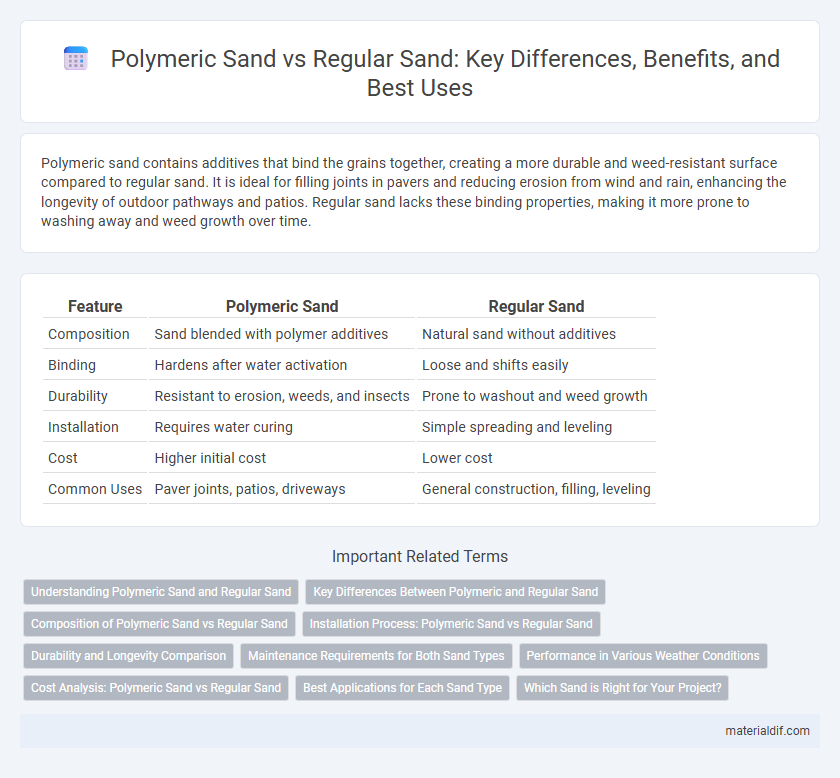Polymeric sand contains additives that bind the grains together, creating a more durable and weed-resistant surface compared to regular sand. It is ideal for filling joints in pavers and reducing erosion from wind and rain, enhancing the longevity of outdoor pathways and patios. Regular sand lacks these binding properties, making it more prone to washing away and weed growth over time.
Table of Comparison
| Feature | Polymeric Sand | Regular Sand |
|---|---|---|
| Composition | Sand blended with polymer additives | Natural sand without additives |
| Binding | Hardens after water activation | Loose and shifts easily |
| Durability | Resistant to erosion, weeds, and insects | Prone to washout and weed growth |
| Installation | Requires water curing | Simple spreading and leveling |
| Cost | Higher initial cost | Lower cost |
| Common Uses | Paver joints, patios, driveways | General construction, filling, leveling |
Understanding Polymeric Sand and Regular Sand
Polymeric sand is a mixture of fine sand combined with special additives or polymers that harden when activated by moisture, enhancing joint stability and preventing weed growth in pavers. Regular sand, typically composed of natural silica particles, lacks binding agents and can shift or wash away easily, leading to joint erosion and weed infiltration. Understanding these differences is crucial for selecting the right joint material in paving projects to ensure durability and low maintenance.
Key Differences Between Polymeric and Regular Sand
Polymeric sand contains a mixture of sand and special additives, such as binders, which harden when moistened, providing enhanced stability and preventing weed growth compared to regular sand. Regular sand lacks these binding agents, making it more prone to erosion, shifting, and weed infiltration in pavements and joints. The key differences lie in polymeric sand's superior durability, resistance to pests and erosion, and ability to lock pavers securely, whereas regular sand offers basic filling without added protective properties.
Composition of Polymeric Sand vs Regular Sand
Polymeric sand consists of a mixture of fine sand and specialized polymers that activate with water to form a binding agent, enhancing joint stability and reducing weed growth. Regular sand primarily contains natural fine grains with no binding properties, making it prone to erosion and washout over time. The polymeric composition provides superior durability, water resistance, and resistance to insects compared to the loose, granular nature of regular sand.
Installation Process: Polymeric Sand vs Regular Sand
Polymeric sand requires precise installation involving clean, dry joints, followed by careful application and misting to activate the binding agents for stability and weed resistance. Regular sand installation is simpler, involving spreading and sweeping sand into joints without any curing process, making it less labor-intensive but prone to erosion and weed growth. The polymeric sand installation process demands more time and skill to ensure durability, while regular sand offers ease of use but lower long-term performance.
Durability and Longevity Comparison
Polymeric sand offers superior durability compared to regular sand due to its binding agents that resist erosion, weed growth, and insect intrusion, providing long-lasting stability for pavers and joints. Regular sand tends to wash away more easily under heavy rain or wind, reducing its effectiveness and requiring frequent replenishment. The longevity of polymeric sand extends the lifespan of outdoor surfaces by maintaining joint integrity and preventing shifting or settling over time.
Maintenance Requirements for Both Sand Types
Polymeric sand requires less frequent maintenance than regular sand due to its binding agents that resist erosion, weed growth, and insect infestation, reducing the need for regular refilling and cleaning. Regular sand tends to wash away or shift with heavy rain or foot traffic, necessitating periodic replenishment and more intensive weed management. Choosing polymeric sand can significantly lower long-term upkeep, especially in high-traffic or exposed paving areas.
Performance in Various Weather Conditions
Polymeric sand outperforms regular sand in diverse weather conditions by binding more effectively and resisting erosion from rain and wind, ensuring longer-lasting stability for pavers. Its composition includes fine sand particles coated with polymer binders that harden upon water activation, preventing washouts and weed growth. Regular sand, lacking these binding agents, tends to wash away or shift during heavy rains and freeze-thaw cycles, reducing its performance in maintaining joint integrity.
Cost Analysis: Polymeric Sand vs Regular Sand
Polymeric sand typically costs $1 to $2.50 per pound, making it more expensive than regular sand, which averages $0.10 to $0.50 per pound. Despite higher upfront costs, polymeric sand reduces long-term maintenance expenses by preventing weed growth and erosion. Over time, this cost efficiency often offsets initial investment, especially in high-traffic or decorative paving projects.
Best Applications for Each Sand Type
Polymeric sand is ideal for filling joints in pavers, patios, and walkways due to its ability to harden and resist erosion, weed growth, and insect infestation. Regular sand is best suited for applications requiring drainage and stability, such as base layers under concrete slabs, playgrounds, and landscaping projects. Choosing polymeric sand enhances the durability of decorative hardscapes, while regular sand provides a cost-effective solution for structural support and soil conditioning.
Which Sand is Right for Your Project?
Polymeric sand offers enhanced stability and weed resistance compared to regular sand, making it ideal for paver joints and outdoor surfaces prone to erosion. Regular sand is more cost-effective and suitable for projects where strong binding and impermeability are less critical. Choosing the right sand depends on factors like project type, durability requirements, and exposure to weather elements.
Polymeric Sand vs Regular Sand Infographic

 materialdif.com
materialdif.com